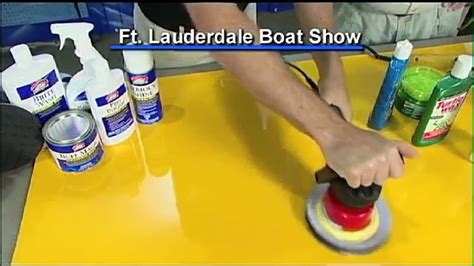How To Remove Oxidation On A Boat
Ronan Farrow
Apr 02, 2025 · 4 min read

Table of Contents
How to Remove Oxidation on a Boat: A Comprehensive Guide
Oxidation is a common problem for boat owners, causing that dull, faded look on your vessel's gelcoat. But don't despair! With the right approach and some elbow grease, you can restore your boat's shine and protect it from further damage. This comprehensive guide will walk you through the process of removing oxidation from your boat, step-by-step.
Assessing the Damage: How Bad is the Oxidation?
Before you start, it's crucial to determine the severity of the oxidation. This will dictate the cleaning method you'll need to employ.
- Mild Oxidation: This presents as a slight dullness or haze. You might notice a loss of gloss, but the gelcoat’s color remains relatively vibrant.
- Moderate Oxidation: The dullness is more pronounced, and you might see some surface etching or pitting. The gelcoat color might appear faded or chalky.
- Severe Oxidation: This is characterized by significant surface damage, deep etching, and a severely faded or chalky appearance. The gelcoat might feel rough to the touch.
Gathering Your Supplies: What You'll Need
The specific products you'll need will depend on the severity of the oxidation, but here's a general list:
- Boat Wash: A dedicated marine wash soap is crucial. Avoid harsh detergents that can damage the gelcoat.
- Various Grades of Abrasive Compounds: You'll likely need a range, from a mild rubbing compound for lighter oxidation to a more aggressive cutting compound for severe cases. Look for compounds specifically designed for marine use.
- Wax and Polish: These help protect your boat's gelcoat after cleaning and restoring its shine.
- Microfiber Cloths: These are essential for preventing scratches and ensuring a streak-free finish. Multiple cloths are recommended for different cleaning stages.
- Orbital Buffer (Optional but Recommended): For larger boats or more severe oxidation, an orbital buffer will significantly speed up the process and improve the results. Always use the correct buffer pads for each compound.
- Bucket(s): You’ll need multiple buckets, at least one for washing and rinsing.
- Garden Hose with Spray Nozzle: Essential for rinsing.
- Gloves: Protect your hands.
- Eye protection: Protect your eyes from splashing compounds.
- Tape (Optional): To mask off areas you don't want to polish.
Step-by-Step Oxidation Removal Process
1. Preparation is Key:
- Clean the Boat Thoroughly: Begin by washing your boat with a marine wash soap and plenty of water. Remove all loose dirt, grime, and debris. Pay close attention to areas with heavy buildup. Rinse thoroughly.
- Dry the Surface: Ensure the boat’s surface is completely dry before proceeding to the next step. This prevents water from diluting the compounds.
2. Selecting and Applying the Compound:
- Start with the Mildest Compound: Always begin with the least abrasive compound possible. Work in small sections, applying the compound using a microfiber cloth or buffer pad.
- Gentle but Firm Pressure: Apply consistent, moderate pressure. Avoid excessive pressure, which can cause unnecessary damage.
- Proper Buffing Techniques: Use overlapping strokes to ensure even coverage. Allow the compound to work its magic before wiping off with a clean microfiber cloth.
- Assess and Repeat: After each section, inspect the results. If the oxidation remains, you may need to move to a more aggressive compound.
3. Waxing and Polishing:
Once the oxidation is removed, apply a high-quality marine wax to protect the gelcoat from future damage and restore its shine. Follow the wax manufacturer’s instructions.
4. Final Rinse and Inspection:
Give your boat one last rinse and inspect your work. If necessary, repeat steps as needed for stubborn spots.
Maintaining Your Boat's Shine
Regular cleaning and waxing are essential for preventing future oxidation. A simple wash and wax every few weeks will go a long way in preserving your boat's finish.
Addressing Severe Oxidation: When to Seek Professional Help
If you're dealing with severe oxidation, it's best to consult a professional boat detailing service. They have the expertise and equipment to handle extensive damage effectively.
By following these steps and utilizing the appropriate products, you can effectively remove oxidation from your boat and restore its gleaming beauty. Remember, patience and the right technique are key to achieving optimal results.
Featured Posts
Also read the following articles
| Article Title | Date |
|---|---|
| How To Set Up A Saltwater Pool | Apr 02, 2025 |
| How To Snap A Football Shotgun | Apr 02, 2025 |
| How To Style Sheepskin Rug | Apr 02, 2025 |
| How To Tighten E Bike Brakes | Apr 02, 2025 |
| How To Test A Rear Window Defroster | Apr 02, 2025 |
Latest Posts
-
How To Write 210 000 In Words
Apr 03, 2025
-
How To Wrap The Moby
Apr 03, 2025
-
How To Worship Mammon
Apr 03, 2025
-
How To Worship A King Zach Neese
Apr 03, 2025
-
How To Work For Insurance Companies As A Contractor
Apr 03, 2025
Thank you for visiting our website which covers about How To Remove Oxidation On A Boat . We hope the information provided has been useful to you. Feel free to contact us if you have any questions or need further assistance. See you next time and don't miss to bookmark.
